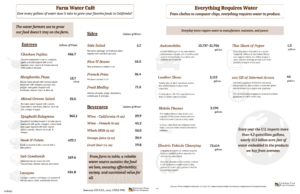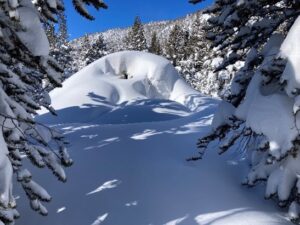CFWC’S 2019 Summer Blogger Tour
At the end of June, CFWC invited three bloggers from across California to join us for an in-depth view of a small slice of California agriculture. This has become a tradition of the California Farm Water Coalition. Sharing California agriculture with the public requires bringing the public to view first-hand what makes our farms special- and that’s what we do on our blogger tours.
Getting to take those so in love with the culinary creations they make and showing them how it is grown is the perfect pairing. The bloggers truly enjoy getting the behind the scenes tour and hearing from the heart of the men and women dedicated to farming and agriculture. Sharing their first-hand experiences with the public, bloggers and social media influencers are carrying the reality of farming into our urban communities.
CFWC invited three great bloggers this year to join us for one of our best tours yet! Liren Baker is a food blogger based out of San Francisco. She has always enjoyed food and transformed this affection into her blog Kitchen Confidante. The second is Chelsea Foy of Lovely Indeed based out of Modesto. Her blog, with its expansive following, has blossomed over the years into a full lifestyle theme including motherhood, travel, shopping and of course, food. We were also joined by Evi Aki of Ev’s Eats, a food blogger out of Los Angeles. Evi shares recipes she loves to make, places she loves to eat and a look at her recently released cookbook.
The region we choose to highlight changes with each tour and this time it focused on the Central San Joaquin Valley. Based out of Fresno, we explored the surrounding area to see the wide variety of foods grown here, and the businesses that depend on those farms.
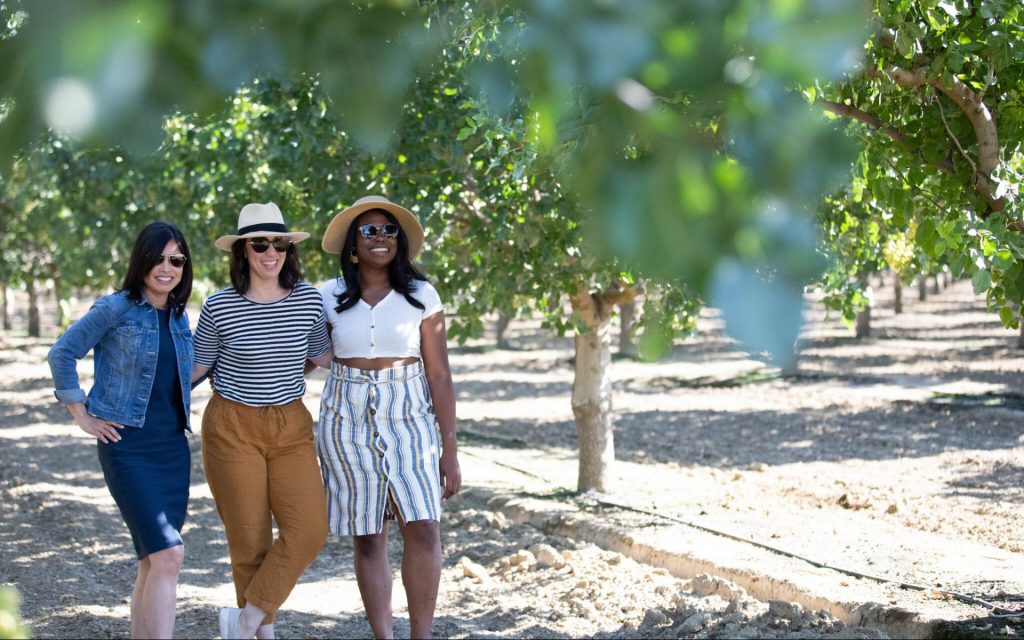
Day One- Getting Underway
Our blogger guests joined us Friday morning and we hit the road for the next two days. We started with the Gibson Farmers Market located at CSU Fresno. This farm stand is an icon in the Central Valley, serving their patrons with fresh produce, meats, nuts, ice cream, wine, and much more, all produced by the students as they learn the sciences and arts of agriculture. Their famous sweet corn is a staple of the summer with many local consumers buying it each morning for their evening meal. After exploring the store, we visited the fields where the produce was grown and harvested just earlier that morning. Beyond enjoying all of the goodies, our bloggers were blown away to learn that a local university is putting so much emphasis on teaching the next generation about growing food while sharing it with the community.
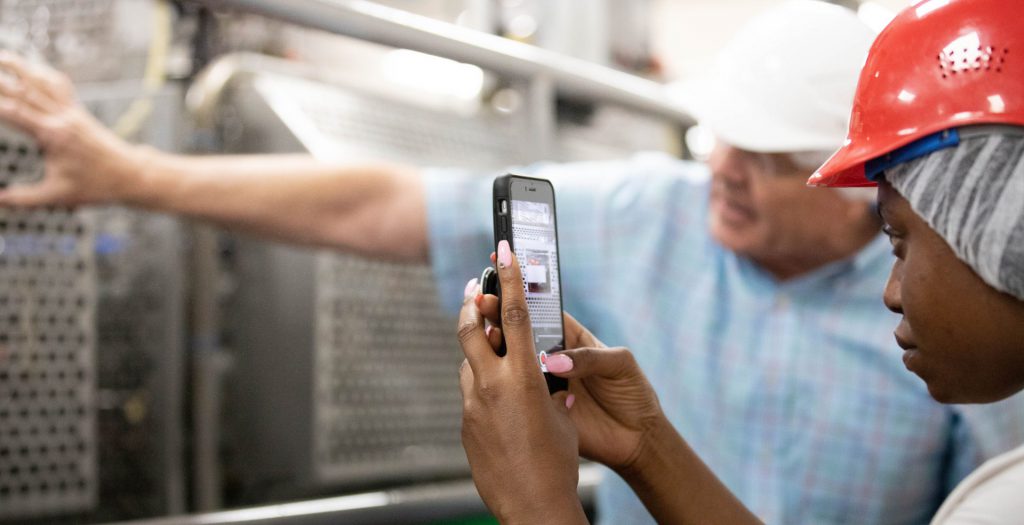 Next we visited Wawona Frozen Foods, where we were given a tour by the father-daughter team of Bill Smittcamp & Blair Smittcamp-Martin, part of the family team that runs the company. They began as a small farm over 50 years ago and since have transformed into one of the only frozen fruit processors remaining in the region. In addition to providing a fresh-tasting product, they also put huge emphasis on food safety and running their operation sustainably. They have partnered with the USDA to create healthy lunches for schools. They are a great partner to the local farmers growing stone fruit. Their fruit is used in a number of products like fruit cups and baked goods. Chances are you have had their fruit before without knowing it – and we bet it was delicious!
Next we visited Wawona Frozen Foods, where we were given a tour by the father-daughter team of Bill Smittcamp & Blair Smittcamp-Martin, part of the family team that runs the company. They began as a small farm over 50 years ago and since have transformed into one of the only frozen fruit processors remaining in the region. In addition to providing a fresh-tasting product, they also put huge emphasis on food safety and running their operation sustainably. They have partnered with the USDA to create healthy lunches for schools. They are a great partner to the local farmers growing stone fruit. Their fruit is used in a number of products like fruit cups and baked goods. Chances are you have had their fruit before without knowing it – and we bet it was delicious!
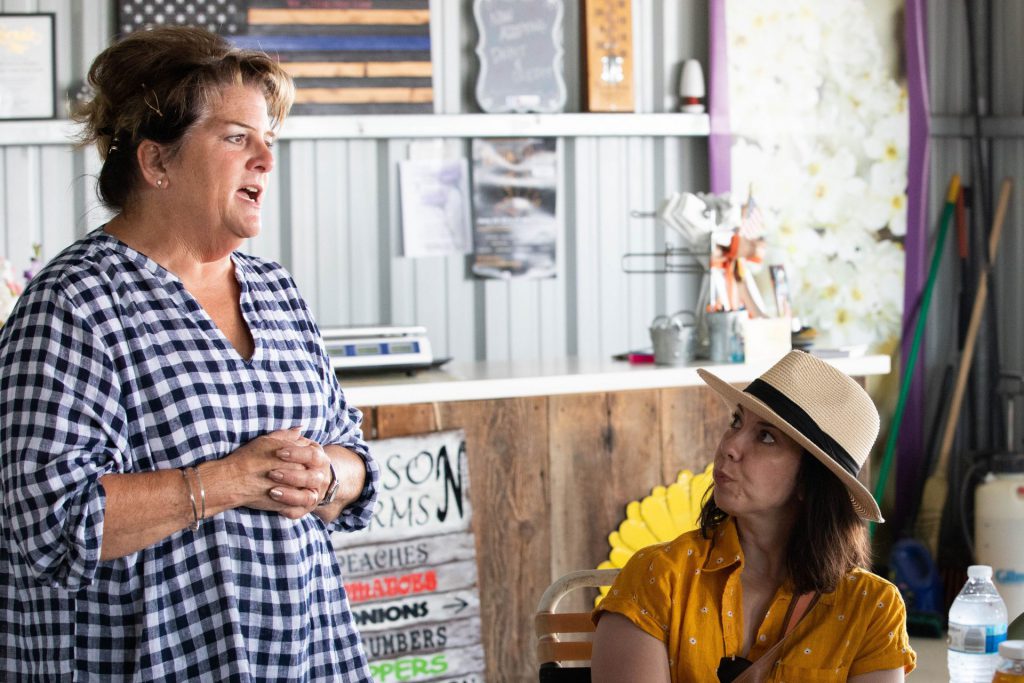
Stop number three of the day was another sweet one! We traveled to Sanger to see Liz Hudson of Hudson Farm Stand. She and her husband have farmed stone fruit for decades, but more recently planted a diversity of fruits and vegetables to sell at their farm stand. You can count on them for fresh fruit, delicious vegetables and great hospitality as many guests from across the world do each summer. We were greeted with her famous peach and blueberry cobbler that rivals any dessert you’ve had. Liz has been a great friend of the California Farm Water Coalition and recently stepped down from our board after being a Board member for nearly 30 years. This stop was a great chance for us all to see what it is like to be a farmer, with our bloggers learning about all the victories and hardships that farmers experience throughout the season.
We ended the day visiting Cruff Farms in Kingsburg where we were hosted by Larry and Sharon Cruff, who grows grapes. Our visit started in the vineyards where their vines are growing the 2019 grape crop that will be dried into your favorite Sun-Maid Raisins. Larry walked us through the process from start to finish and our bloggers learned how the Cruff Farm has become more efficient over the years. Did you know most vineyards that grow grapes for raisins are planted in rows from east to west to aid in drying of the grapes? Not all of us did either until Larry shared his behind-the-scenes knowledge. Larry shared how they use water to grow the fruit and all his efforts to be as sustainable as he can, including a sustainability certification. The visit ended with a generous supply of sweet Sun-Maid raisins in a goodie bag with all the different types of raisins you could imagine, including new tart watermelon-flavored raisin snack (hitting the shelves soon!) (One of our bloggers large raisin supply set off all of the TSA red flags on her way back to the Bay, but it was worth it to enjoy the tasty treat!)
Day Two- The Open Road
Day two started with a drive toward the northwest with a few quick pit stops along the way to learn more about the crops, farms, and growing practices of the area. We explored some of the passing pistachio and pomegranate orchards and were lucky enough to see a cotton field in bloom. We visited Stamoules Produce, where Chuck Dees showed us the different stations in their fresh vegetable chilling facility. Sweet corn that was being harvested that day was packed into boxes in the fields surrounding the facility. Once transported to a central facility, it is chilled and covered with ice to remain fresh before making its way into a truck to be shared with the rest of the nation. Chuck explained a bit about the farm and the needs of the crops as we toured the equipment yard and some of the surrounding acres growing the numerous other crops they produce throughout the year.
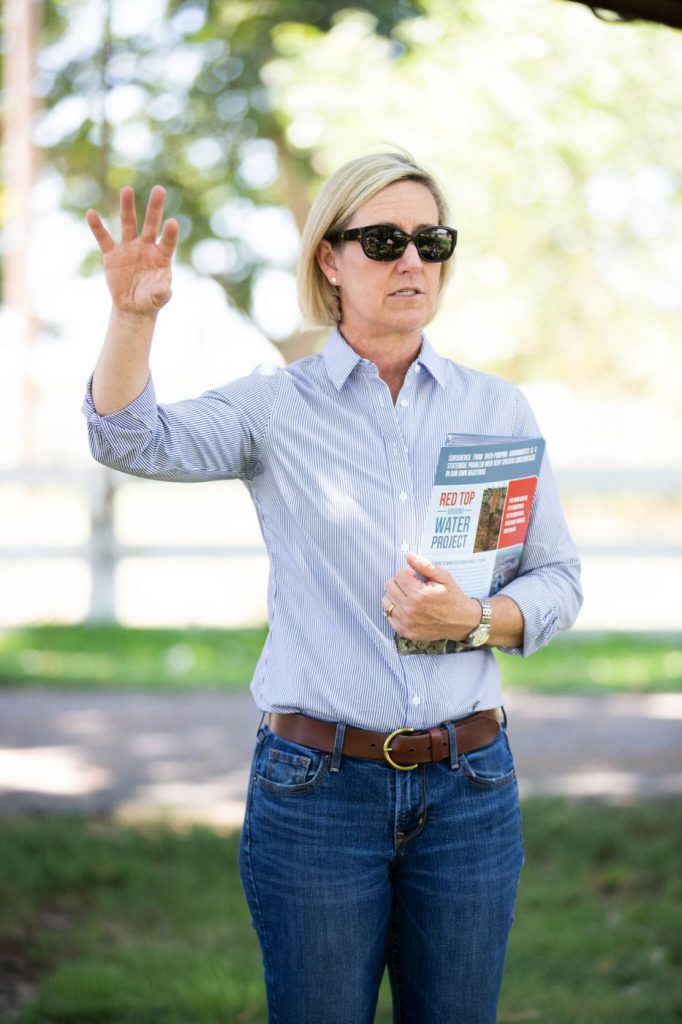
Next, we visited with Sarah Woolf in the Red Top region, near Chowchilla. Our bloggers had a chance to learn more about how groundwater and surface water work together to provide a sustainable supply for farms in the region. Sarah has dedicated her life to helping the public understand water efficiency and agriculture, something our bloggers could appreciate. It was great to hear how farmers throughout this region have worked to have access to water for their crops and how they use it efficiently with the help of technological advances, and regional cooperation- especially during the recent drought.
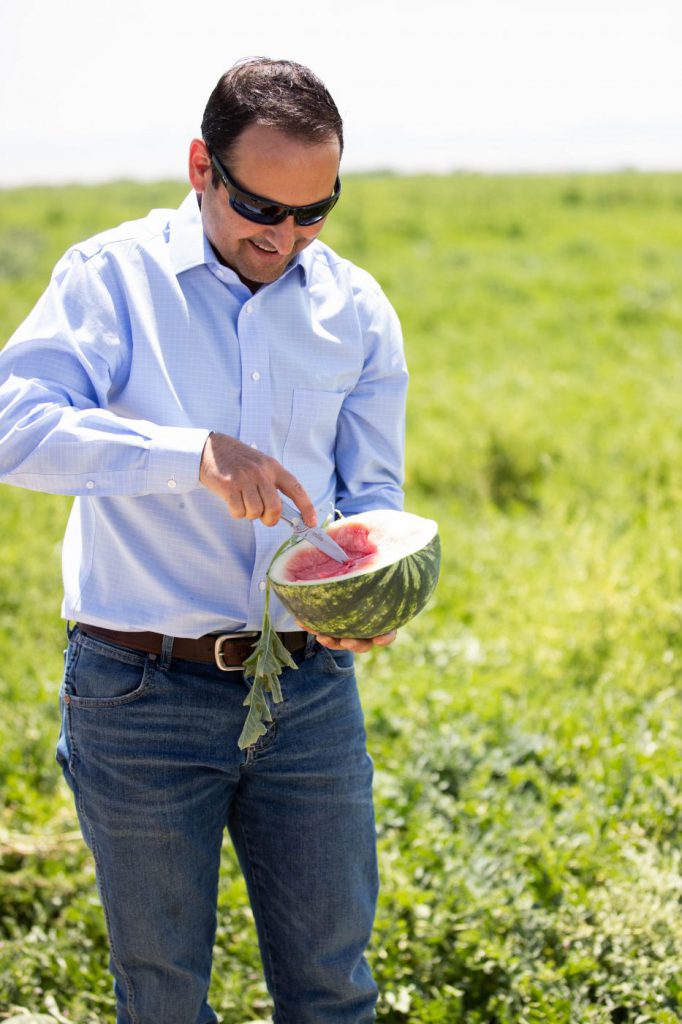
We then traveled to Bowles Farming Company, an operation that has called Los Banos home for over six generations. Vice President Derek Azevedo joined us for lunch and shared some of the history of the farm and the surrounding region, along with some great insights into the farm and the consumers who rely on it.
We discussed many of the advancements Bowles Farming has implemented to grow their diverse crops efficiently using less water and resources while maintaining quality and safety. Our bloggers were excited to head out into the fields, where we picked fresh tomatoes and Derek dug up some fresh carrots. Our last field was planted to watermelons where we saw and tasted the difference between female and male watermelons (yes, you read that right).
The last stop for the trip was at Volta Wildlife Area, with Chris White of Central California Irrigation District and Ken Swanson from Grassland Water District.
The two showed us how water management in the region has evolved over the years, with local farm water suppliers and environmental water users cooperating to improve local conditions. It was especially interesting to see the strong partnership between agriculture and environmental lands, including those critical to the needs of migratory waterfowl as they move along the Pacific Flyway. Working together, we are able to efficiently use this resource.
The last night of our tour was capped off with a great dinner with Dan Errotabere, a local grower. He shared a very practical look into what farming looks like on his farm, including how it has changed over the years. Like many farmers, he was raised on their farm and began working there as a young boy helping his father. He then took over the operation and has seen the new advancements that have become available for him to implement to aid in efficiency.
Sharing their Experience
These two days gave our bloggers a great introduction not only to how food is grown but also deeper topics like water efficiency, labor and the challenge of unexpected weather. It started a great conversation about the pride of California’s farmers to grow fresh and safe food that feeds Californians, Americans and even people across the globe.
For the bloggers, this new knowledge will now accompany the incredible dishes they make for their blog using fresh California-grown foods. We are so glad they joined us for the adventure and can’t wait to see where the California Farm Water Coalition Blogger Tour is headed next!

Check out the summaries the bloggers posted from the trip:
It’s Saturday, and farmers markets across the country are bustling and bursting with summer’s bounty. For many of us, that might be the closest we get to learning more about the food we eat. I’m feeling especially blessed this weekend to be spending it in the fertile fields of my beloved California, in the Central Valley, at the heart of harvest season, with my friends at @farmwater. We’re having heart to heart conversations with the farmers who are generously sharing so much of themselves and the work that goes into the summer peaches you bought this morning and the sweet corn you’ll be grilling tonight. In the many years and farm tours I’ve had the honor of joining in the last nine years, the conversations have changed and now more than ever, water is the precious resource that farmers are working hard to protect with innovation to keep providing our country with healthy food. For each pistachio I snack on, frozen peach I drop in the smoothie blender, and cup of almond milk I drink, I will think of the water it takes to make each day delicious. I hope you join me on my #instastories as I share their stories! And the next time you go to the market, talk to your farmers. Get to know them better. Understand your food better.
– Liren Baker | Kitchen Confidante
When you pick up a carrot, or a peach, or a tomato at the grocery store, you’re looking at so much more than just that produce. You’re looking at the farmer who planted it and tended it, the water that grew it, the laborers or the technology that harvested it, the people who packed it, the transportation that got it to you. Traveling my home state with @farmwater and the #cfwcfarmtour this weekend has filled me up more than ever with pride in California, gratefulness for the farmers who grow our food, and appreciation for the fresh, amazing foods we eat. What do you wonder about your food? Do you ever think about where it comes from? If you have a question, leave it in the comments.
– Chelsea Foy | Lovely Indeed
Hope you’ve been enjoying my little farm series! Wanted to share a quote I saw that’s been stuck with me this weekend… “more than a business, the family farm is a lifestyle- its an ideal worth preserving” Where our food comes from, how it’s produced, & manufactured is so important! It’s been nice to see that California farmers take such care in delivering us the best not only in producing our food but preserving & managing water which is literally the key to life. I will definitely think twice about where my food is coming from when I shop now!
– Evi Aki | Ev’s Eats

